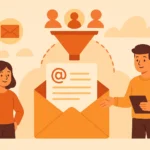Now Reading: Top 5 E-Learning Content Engagement Strategies That Actually Work
-
01
Top 5 E-Learning Content Engagement Strategies That Actually Work
Top 5 E-Learning Content Engagement Strategies That Actually Work

In a world where the average employee dedicates just 3 hours per month to learning, creating engaging e-learning content isn’t just nice to have – it’s essential for survival. The right e-learning content engagement strategies can transform those precious minutes into meaningful learning experiences that stick.
In this guide, I’ll walk you through the e-learning content engagement strategies that have consistently delivered higher completion rates, better knowledge retention, and stronger ROI.
Key Takeaways
To increase engagement in e-learning content:
- Create interactive elements like quizzes, simulations, and branching scenarios
- Incorporate storytelling techniques to make content relatable and memorable
- Design with your audience in mind, keeping content relevant and accessible
- Use multimedia elements strategically (videos, infographics, animations)
- Keep content concise-respect that learners only have about 3 hours monthly for training
- Measure engagement metrics and continuously refresh content based on feedback
Create Interactive Content That Demands Participation
Interactivity is the cornerstone of engaging e-learning experiences. When learners actively participate rather than passively consume, retention rates soar and learning becomes meaningful. Research shows that interactive e-learning can improve information retention by up to 60%, making it one of the most powerful engagement strategies available.
Beyond Meaningless Clicking
Effective interactivity isn’t about random clicking-it’s about meaningful engagement that happens in the brain, not just with the mouse. As you design interactive elements, ask yourself: “Does this interaction help learners process and apply the information?”
Here are interactive elements that consistently drive engagement:
- Decision-based scenarios: Present learners with realistic situations where they must make choices and see the consequences. This works particularly well for soft skills training like management or customer service.
- Knowledge check quizzes: Integrate quick assessments throughout your content to reinforce learning and provide immediate feedback. These work best when they test application rather than mere recall.
- Simulations: Allow learners to practice skills in a safe environment before applying them in real-world situations. For example, a simulation of a difficult customer conversation gives sales representatives practice without real-world consequences.
- Drag-and-drop activities: These simple interactions can make classification, ordering, or matching exercises more engaging than text-based alternatives.
Implementation Tips
When implementing interactive elements, I recommend following these guidelines:
- Align each interaction with a specific learning objective
- Provide clear instructions and meaningful feedback
- Ensure interactions work seamlessly on all devices, especially mobile
- Balance challenge level-too easy becomes boring, too difficult becomes frustrating
By thoughtfully incorporating interactive elements that require meaningful participation, you transform passive content consumption into active learning experiences.
Useful Articles:
Harness The Power Of Storytelling
Stories have captivated human attention since the beginning of time, and they remain one of the most powerful e-learning content engagement strategies available. When I incorporate storytelling into e-learning, I consistently see higher completion rates and better knowledge retention.
Why Storytelling Works
Stories create emotional connections that make learning memorable. They provide context for abstract concepts and help learners see the relevance of the material to their own lives and work. When information is embedded in a narrative, it becomes easier to recall and apply.
Effective Storytelling Techniques
Here are proven storytelling approaches that enhance e-learning engagement:
- Character-driven narratives: Create relatable characters facing challenges similar to those your learners encounter. For example, in compliance training, follow a character navigating ethical dilemmas in realistic workplace scenarios.
- Case studies: Real-world examples demonstrate the practical application of concepts and show learners the “why” behind the information.
- Branching scenarios: Allow learners to make decisions that affect how the story unfolds, creating personalized learning paths and demonstrating consequences of different choices.
- Before and after contrasts: Show situations before and after applying the knowledge or skills being taught to illustrate the value of the learning.
Implementation Tips
When incorporating storytelling into your e-learning content:
- Keep stories relevant to learning objectives and audience context
- Use conversational language rather than formal or technical jargon
- Include emotional elements that resonate with learners
- Ensure diverse representation in your stories and scenarios
- Use visuals to enhance the narrative without overwhelming the content
By weaving concepts into compelling narratives, you transform dry information into engaging experiences that learners can relate to and remember.
Design With Your Audience In Mind
Creating engaging e-learning content starts with understanding who your learners are and what they need. When content feels personally relevant, engagement naturally increases. I’ve found that audience-centered design is one of the most underutilized yet powerful e-learning content engagement strategies.
Know Your Learners
Before designing content, gather information about your audience:
- Demographics: Age, technical proficiency, educational background
- Job roles and responsibilities: How will they apply this knowledge?
- Learning preferences: Do they prefer visual, auditory, or kinesthetic learning?
- Pain points: What challenges are they trying to overcome?
- Time constraints: How much time can they realistically dedicate to learning?
Personalization Strategies
Once you understand your audience, implement these personalization techniques:
- Role selectors: Allow learners to choose their job role at the beginning of the course, then tailor examples and scenarios to that role.
- Adaptive learning paths: Use pre-assessments to determine knowledge gaps, then customize content to address those specific needs.
- Relevant examples: Ensure all case studies and examples directly relate to situations learners encounter in their work.
- Localization: For international audiences, go beyond translation to adapt content to cultural contexts and local business practices.
Accessibility Considerations
Designing for your audience also means ensuring everyone can access and engage with your content:
- Use clear, concise language (aim for an 8th-grade reading level)
- Provide alternative text for images
- Ensure color contrast meets accessibility standards
- Include captions for videos
- Design for mobile users with touch-friendly interactions
By putting your audience at the center of your design process, you create content that feels personally relevant and valuable, naturally increasing engagement and completion rates.
Useful Articles:
Leverage Multimedia Strategically
Multimedia elements can significantly enhance engagement when used purposefully. However, I’ve learned that strategic implementation is key-too many bells and whistles can distract rather than engage. The most effective e-learning content engagement strategies use multimedia to support learning objectives, not just for visual appeal.
Choose The Right Media For The Message
Different types of content call for different multimedia approaches:
- Videos: Ideal for demonstrations, storytelling, and emotional impact. Keep them under 3 minutes for maximum engagement.
- Infographics: Perfect for presenting statistics, processes, or relationships between concepts in a visual format.
- Animations: Excellent for explaining abstract concepts or processes that are difficult to visualize.
- Audio: Useful for accessibility and for learners who prefer auditory learning. Professional narration can add credibility and engagement.
- Interactive graphics: Combine visual appeal with interactivity to create engaging learning experiences.
Implementation Best Practices
When incorporating multimedia elements:
- Maintain relevance: Every multimedia element should directly support a learning objective.
- Ensure quality: Professional-looking visuals and clear audio build credibility and reduce distractions.
- Consider bandwidth: Optimize file sizes for learners with slower internet connections.
- Balance variety: Mix media types to maintain interest without overwhelming learners.
- Provide alternatives: Ensure accessibility by including transcripts for videos and descriptive text for images.
Avoid Common Pitfalls
In my experience, these multimedia mistakes can reduce rather than enhance engagement:
- Autoplay videos or audio that surprise learners
- Decorative animations that distract from content
- Poor quality images or recordings that undermine credibility
- Excessive use of different media types that creates cognitive overload
By thoughtfully selecting multimedia elements that enhance rather than distract from your content, you create a richer, more engaging learning experience that appeals to different learning preferences.
Keep It Concise And Focused
One of the most effective e-learning content engagement strategies is simply respecting learners’ time. With employees dedicating just 3 hours or less per month to learning, every minute must count. I’ve found that concise, focused content consistently outperforms longer, more comprehensive materials in terms of completion rates and knowledge retention.
The Power Of Microlearning
Breaking content into focused, bite-sized modules offers several engagement benefits:
- Fits into busy schedules: 5-10 minute modules can be completed during short breaks
- Reduces cognitive load: Focusing on one concept at a time improves understanding
- Increases completion rates: Shorter modules feel more achievable
- Facilitates just-in-time learning: Targeted modules can be accessed at the point of need
Strategies For Concise Content
Here’s how I approach creating focused e-learning content:
- Start with clear objectives: Define precisely what learners should know or be able to do after completing the module.
- Eliminate nice-to-know information: Include only must-have content that directly supports learning objectives.
- Use the inverted pyramid approach: Present the most important information first, then add supporting details.
- Chunk information logically: Group related concepts together in digestible segments.
- Leverage visuals to replace text: A well-designed infographic can replace paragraphs of explanation.
Writing For Engagement
The way you write dramatically impacts engagement:
- Use conversational language rather than formal academic style
- Replace jargon with simple, clear terminology
- Vary sentence length to maintain interest
- Use active voice for clarity and directness
- Include questions that prompt reflection
By creating concise, focused content that respects learners’ time constraints, you remove a major barrier to engagement and increase the likelihood that learners will complete and retain the material.
Useful Articles:
Measure And Iterate Based On Data
Creating engaging e-learning isn’t a one-and-done process-it requires continuous improvement based on real data. I’ve found that organizations that regularly measure engagement metrics and refine their content accordingly see significantly better results over time. This data-driven approach is one of the most sustainable e-learning content engagement strategies.
Key Metrics To Track
Focus on these engagement indicators:
- Completion rates: What percentage of learners finish each module?
- Time spent: How long do learners engage with specific content?
- Assessment performance: How well do learners perform on quizzes and tests?
- Interaction rates: Which interactive elements receive the most engagement?
- Return visits: Do learners revisit content for reference?
- Feedback scores: How do learners rate their experience?
Gathering Meaningful Feedback
Quantitative metrics tell only part of the story. To truly understand engagement, collect qualitative feedback:
- Embed short surveys within your e-learning modules
- Conduct focus groups with representative learners
- Analyze comments in discussion forums
- Interview managers about observed behavior change
- Use heat mapping to see where learners focus attention
Continuous Improvement Process
Based on the data you collect, implement this iterative improvement cycle:
- Identify patterns: Look for modules with lower engagement or completion rates.
- Analyze potential causes: Is the content too long? Too complex? Not relevant?
- Make targeted changes: Update specific elements rather than overhauling everything.
- Test with a small group: Validate improvements before wide release.
- Measure impact: Compare engagement metrics before and after changes.
Content Refresh Schedule
Even successful content needs regular updates:
- Quarterly: Check for outdated information or broken links
- Bi-annually: Update examples and case studies for relevance
- Annually: Review against current best practices and technologies
By establishing a data-driven culture of continuous improvement, you ensure your e-learning content remains engaging and effective over time, maximizing your return on investment.
Would you like to know more about implementing any specific engagement strategy for your particular learning audience?





















